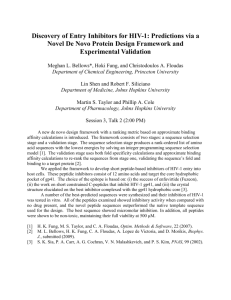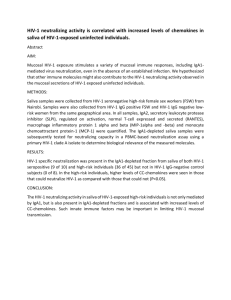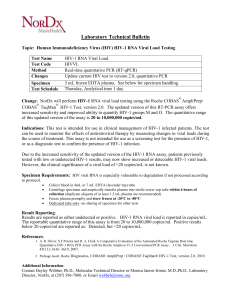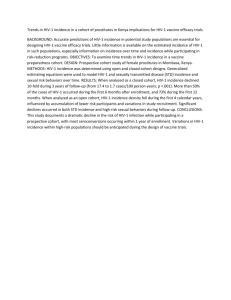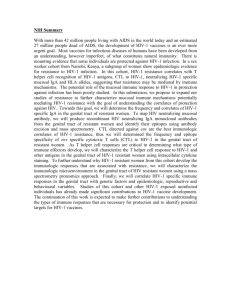KIR2DS4 Promotes HIV-1 Pathogenesis: New Evidence
advertisement
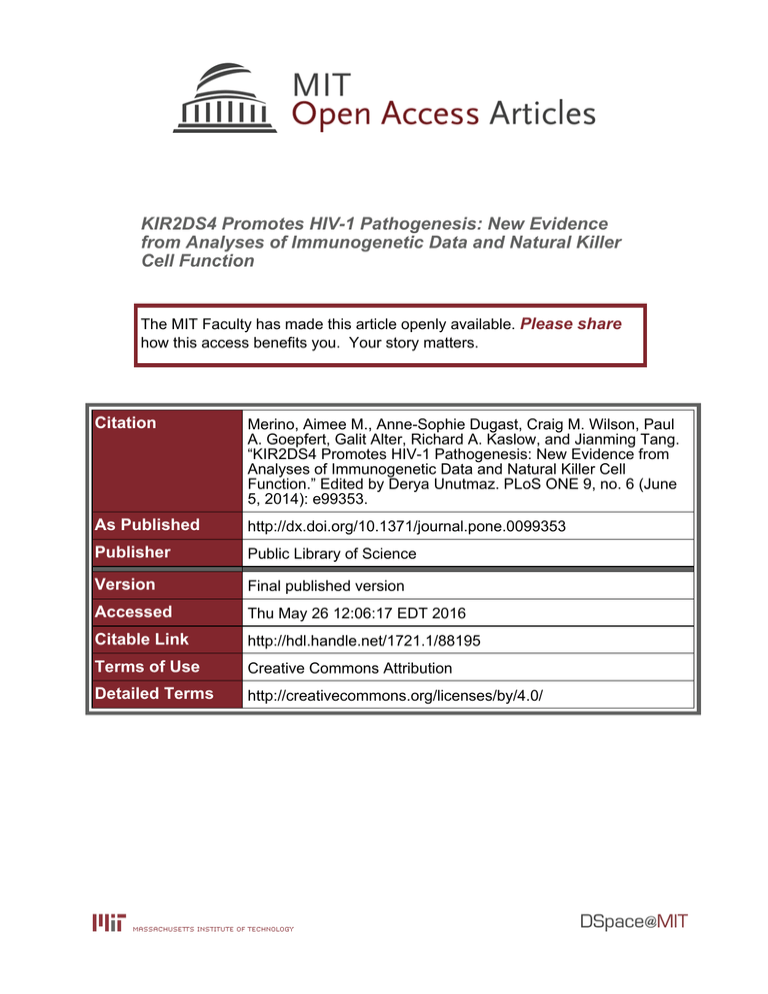
KIR2DS4 Promotes HIV-1 Pathogenesis: New Evidence from Analyses of Immunogenetic Data and Natural Killer Cell Function The MIT Faculty has made this article openly available. Please share how this access benefits you. Your story matters. Citation Merino, Aimee M., Anne-Sophie Dugast, Craig M. Wilson, Paul A. Goepfert, Galit Alter, Richard A. Kaslow, and Jianming Tang. “KIR2DS4 Promotes HIV-1 Pathogenesis: New Evidence from Analyses of Immunogenetic Data and Natural Killer Cell Function.” Edited by Derya Unutmaz. PLoS ONE 9, no. 6 (June 5, 2014): e99353. As Published http://dx.doi.org/10.1371/journal.pone.0099353 Publisher Public Library of Science Version Final published version Accessed Thu May 26 12:06:17 EDT 2016 Citable Link http://hdl.handle.net/1721.1/88195 Terms of Use Creative Commons Attribution Detailed Terms http://creativecommons.org/licenses/by/4.0/ KIR2DS4 Promotes HIV-1 Pathogenesis: New Evidence from Analyses of Immunogenetic Data and Natural Killer Cell Function Aimee M. Merino1,2, Anne-Sophie Dugast3, Craig M. Wilson4, Paul A. Goepfert1,2, Galit Alter3, Richard A. Kaslow1¤, Jianming Tang1,2* 1 Department of Medicine, University of Alabama at Birmingham, Birmingham, Alabama, United States of America, 2 Department of Microbiology, University of Alabama at Birmingham, Birmingham, Alabama, United States of America, 3 Ragon Institute of MGH, MIT, and Harvard, Boston, Massachusetts, United States of America, 4 Department of Epidemiology, University of Alabama at Birmingham, Birmingham, Alabama, United States of America Abstract Background: KIR2DS4 gene variants encode full-length and truncated protein products, with only the former serving as membrane-bound receptors to activate natural killer (NK) cells. We have previously shown that full-length KIR2DS4 was associated with relatively high viral load and accelerated heterosexual HIV-1 transmission. Our objective here was to provide confirmatory data and to offer new insights about the potential mechanisms. Methodology/Principal Findings: Mixed models for repeated (longitudinal) outcome measurements on 207 HIV-1 seropositive American youth revealed an association of full-length KIR2DS4 with relatively high viral load and low CD4+ T-cell count (p,0.01 for both). Depending on KIR2DS4 expression (presence or absence) on cell surface, NK cells from 43 individuals with untreated, chronic HIV-1 infection often differed in functional properties, including degranulation and secretion of IFN-c and MIP-1b. In particular, polyfunctional NK cells were enriched in the KIR2DS4-positive subset. Conclusions/Significance: Full-length KIR2DS4 promotes HIV-1 pathogenesis during chronic infection, probably through the maintenance of an excessively pro-inflammatory state. Citation: Merino AM, Dugast A-S, Wilson CM, Goepfert PA, Alter G, et al. (2014) KIR2DS4 Promotes HIV-1 Pathogenesis: New Evidence from Analyses of Immunogenetic Data and Natural Killer Cell Function. PLoS ONE 9(6): e99353. doi:10.1371/journal.pone.0099353 Editor: Derya Unutmaz, New York University, United States of America Received March 4, 2014; Accepted May 1, 2014; Published June 5, 2014 Copyright: ß 2014 Merino et al. This is an open-access article distributed under the terms of the Creative Commons Attribution License, which permits unrestricted use, distribution, and reproduction in any medium, provided the original author and source are credited. Data Availability: The authors confirm that, for approved reasons, some access restrictions apply to the data underlying the findings. Raw data derived from this study can be shared with third parties once the patient identifiers are removed. Request for access to this dataset, along with an approved human subjects research protocol, can be sent to Dr. Jianming Tang (jtang@uab,edu) or Dr. Paul A. Goepfert (paulg@uab.edu). Funding: The research summarized in this paper was funded by an R01 grant (AI071906) from the National Institute of Allergy and Infectious Diseases (NIAID) to RAK and JT. The Reaching for Excellence in Adolescent Care and Health (REACH) cohort was supported primarily by the National Institute of Child Health and Human Development (U01-HD32830), with supplemental funding from the NIAID, the National Institute on Drug Abuse (NIDA), and the National Institute of Mental Health (NIMH). The funders have no role in study design, data collection, data analysis, decision to publish, or preparation of the manuscript. Competing Interests: Paul A. Goepfert and Jianming Tang are academic editors for PLOS ONE. This does not alter the authors’ adherence to PLOS ONE editorial policies and criteria. All other coauthors have no potential conflicts of interest to declare. * E-mail: jtang@uab.edu ¤ Current address: United States Department of Veterans Affairs, Washington, DC, United States of America with Src homology 2–containing tyrosine phosphatases [7]. Activating KIRs have short (S) cytoplasmic tails that mediates interaction with DAP12, a cytoplasmic protein with an immunoreceptor tyrosine-based activation motif (ITAM) [8]. The extracellular portion of KIR molecules consists of 2 (2D) or 3 (3D) Ig-like domains that can bind to HLA-C or HLA-B molecules, respectively [9]. KIR genes have been associated with various outcomes related to organ transplantation, autoimmue disorders and infectious diseases [10,11]. For example, genotypes encoding KIR3DS1 and KIR3DL1 alleles in combination with their likely ligands (HLABw4) have been associated with protection against HIV-1 disease progression [3,11,12]. Among the 15 functional KIR genes clustered at chromosome 19q13.4, KIR2DS4 defines haplotype A, which has no other genes encoding activating receptors. Truncated forms of KIR2DS4 product lack the transmembrane Introduction As the primary effector cells mediating innate immunity, natural killer (NK) cells are capable of directly destroying virus-infected cells or releasing cytokines to further modulate adaptive immune responses [1]. Several lines of evidence indicate that NK cell functions during HIV-1 infection vary considerably according to the polymorphic nature of killer cell immunoglobulin receptors (KIR) and their natural ligands, especially human leukocyte antigen (HLA) molecules [2,3,4,5]. KIR gene products are stochastically expressed on NK cells and the balance between activating and inhibitory KIRs is critical to cytolysis and other immune function (e.g., cytokine secretion) [6]. In general, inhibitory KIRs are characterized by long cytoplasmic tails (designated by ‘‘L’’ in the gene name) that carry an immunoreceptor tyrosine-based inhibition motif (ITIM), which interacts PLOS ONE | www.plosone.org 1 June 2014 | Volume 9 | Issue 6 | e99353 KIR2DS4 and HIV-1 Pathogenesis count was also unfavorable in both univariable (nominal D = 264624, p = 0.008) and multivariable models (adjusted D = 259624, p = 0.021) (Table 2). The association of full-length KIR2DS4 with longitudinal VL and CD4 count did not require the presence of HLA-C*04 that encodes a known ligand for the KIR2DS4 product [14]. For example, VL in 98 youth who had full-length KIR2DS4 but no HLA-C*04 had higher VL (0.3860.09 log10) than did subjects (n = 31) who were doubly negative for full-length KIR2DS4 and HLA-C*04 (p,0.001). Subjects with full-length KIR2DS4 all had unfavorable outcomes also regardless of the two major HLA-C allele groups (C1 and C2) (p = 0.002 to ,0.001 in mixed models), being consistent with results reported for HIV-1-infected Zambians [5]. Another reported KIR2DS4 ligand, HLA-A*11 [14], is too rare (,2%) in our study population to allow any meaningful analysis. domain for cell surface expression [13]. In our previous work based on 566 HIV-1 serodiscordant Zambian couples, presence of full-length KIR2DS4 (*001 and *001-like alleles) in chronically infected Zambians was independently associated with accelerated transmission of HIV-1 to cohabiting seronegative partners (RH = 2.00, p = 0.004), mostly independent of its association with higher (VL) (b = 0.1760.08, p = 0.04) [5]. To further illustrate the importance of KIR2DS4 to HIV-1 pathogenesis, we have analyzed 207 HIV-1-infected American youth to provide confirmatory immunogenetic findings. The results were highly consistent with our earlier hypothesis. In addition, we observed that NK cells with and without KIR2DS4 expression often differed in their functional properties, especially in terms of degranulation (production of CD107a) and/or induction of IFN-c and MIP-1b. Results Characteristics of Additional Subjects for Analysis of NK Cell Function Characteristics of HIV-1-infected Youth with Longitudinal Outcome Measures For ex vivo and in vitro assays, we analyzed existing and crosssectional samples from 43 adults with chronic HIV-1 infection (Table 1). When stratified by KIR2DS4 genotypes, 23 had fulllength alleles, and the remainder (n = 20) had truncated forms only. The two subgroups were highly comparable in terms of: (i) sex ratio (47.8% and 45.0% females, respectively); (ii) ethnic background (p = 0.83), and (iii) distribution of other activating KIR genes (KIR2DS1, KIR2DS2, KIR2DS3, KIR2DS5 and KIR3DS1 (p. 0.050) (data not shown). Among 207 HIV-1-infected youth with 3–4 eligible (treatmentfree) visits for this study (Table 1), 75.3% were female, and 77.3% self-identified as African American. Their mean age was 18.1 years (range 13.1–21.8), with females being slightly older (18.361.2 years) than males (18.061.4) (p = 0.107). The average VL measured at quarterly follow-up visits was 3.86 log10 (range = 0.95–5.49), and the average CD4+ T-cell (CD4) count was 475 cells/mL (range = 203–1461). These virologic and immunologic outcomes differed by age and sex (Table 2), but not by race (data not shown). KIR2DS4 Expression Profile on NK Cells during Chronic HIV-1 Infection Full-length KIR2DS4 as a Correlate of Unfavorable Outcomes in HIV-1-infected Youth As expected from stochastic expression of KIRs on NK cells [15], membrane-bound KIR2DS4 receptor was found on a subset of CD3-negative, CD56-positive and/or CD16-positive NK cells in subjects with the full-length KIR2DS4 gene (i.e., g+); NK cells from subjects without full-length KIR2DS4 (g2) were naturally all negative for the membrane-bound gene product (p2) (Figure 1). For KIR2DS4 gene-positive (g+) subjects alone, the proportion of NK cells with KIR2DS4 on cell surface varied from 1.28–46.8% (median = 13.9%). NK cells stained positive for KIR2DS4 were predominantly CD3negCD56dimCD16pos (median = 85.4%, range = 26.4–100%), with some in the CD3negCD56negCD16pos subset (median = 9.6%, range = 0–59.6%), and very few in the CD3negCD56brightCD16neg subset (median = 0.1%, range = 0– In univariable comparisons of repeated outcome measures, genotypes corresponding to full-length KIR2DS4 (*001 and *001like alleles) were associated with relatively high VL (D = 0.2960.09 log10, p = 0.002) (Table 2). This association remained true in a multivariable model that adjusted for the effects of age and sex (adjusted D = 0.2860.09 log10, p = 0.002). When conditioned on full-length KIR2DS4, the association of female sex with relatively low VL (p = 0.010) clearly diminished (adjusted p = 0.302 in the multivariable model), but there was no evidence for potential interactions between full-length KIR2DS4 and sex (p = 0.274 for the interaction term). The effect of full-length KIR2DS4 CD4 Table 1. Characteristics of two study populations with longitudinal and cross-sectional data, respectively. Subjects with longitudinal data Subjects with cross-sectional data Full-length KIR2DS4 (n = 160) Only truncated KIR2DS4 (n = 47) Full-length KIR2DS4 (n = 23) Only truncated KIR2DS4 (n = 20) Age (years): median and range 18 (13–22) 18 (14–21) 39 (17–57) 37 (17–50) African American: n (%) 126 (78.8) 34 (72.3) 17 (73.9) 15 (75.0) Other races: n (%) 34 (21.3) 13 (27.7) 5 (21.7) 5 (25.0) Female: n (%) 117 (73.1) 41 (87.2) 11 (47.8) 9 (45.0) Male: n (%) 43 (26.9) 6 (12.8) 12 (52.2) 11 (55.0) Baseline characteristics HIV-1 VL (log10): median (range) 3.8 (1.0–5.5) 3.8 (1.0–5.3) 4.0 (2.0–6.7) 4.0 (2.2–5.6) CD4 count: median (range) 556 (230–1461) 584 (201–990) 577 (203–970) 490 (210–1414) Notes: HIV-1 viral load (VL) in plasma (RNA copies/mL) and CD4+ T-cell (CD4) count in peripheral blood (cells/mL) are the two outcomes (see text). The two subgroups with existing PBMC samples share similar features at study entry (p.0.45 in all comparisons). doi:10.1371/journal.pone.0099353.t001 PLOS ONE | www.plosone.org 2 June 2014 | Volume 9 | Issue 6 | e99353 KIR2DS4 and HIV-1 Pathogenesis Table 2. Associations of full-length KIR2DS4 gene with longitudinal viral load (VL) and CD4+ T-cell (CD4) count in 207 youth with chronic (seroprevalent) HIV-1 infection. Predictors (independent variables) Univariable models VL: D ± SE Multivariable model P r2 VL: D ± SE P Age (per year) 0.1160.06 0.013 0.022 0.1260.08 0.018 Female sex 20.1760.09 0.049 0.007 20.0960.09 0.302 Full-length KIR2DS4 0.2960.09 0.002 0.011 0.2860.09 0.002 CD4: D ± SE P r2 CD4: D ± SE P Age (per year) 226612 0.038 0.015 22467 0.015 Female sex 66623 0.003 0.004 50623 0.001 264624 0.008 0.010 259624 0.021 Full-length KIR2DS4 2 Notes: The overall r = 0.039 and 0.033 in the multivariable models for VL and CD4 count, respectively. There is no clear interaction between full-length KIR2DS4 (gene) and sex (p = 0.274). doi:10.1371/journal.pone.0099353.t002 1 infection by chronically infected individuals [5]. The association between full-length KIR2DS4 and relatively low CD4 count in chronically infected American youth corroborates our original data from HIV-1-infected Zambians who lacked CD4 data. Our North American youth cohort had an additional advantage with longitudinal data before therapy, which improved statistical power when the effects of genetic factors were assessed in mixed models. Beyond demonstrating a consistent relationship between fulllength KIR2DS4 and enhanced HIV-1 pathogenesis in both Africans infected with HIV-1 subtype C viruses and North Americans infected with HIV-1 subtype B, our ex vivo and in vitro data further point to potential mechanisms for KIR2DS4-related NK cell functions. KIR2DS4 expression (KIR2DS4 staining) was mostly seen with the CD3negCD56dimCD16pos subset of NK cells that are expected to be more cytolytic than the CD3negCD56brightCD16neg (KIR2DS4-negative) subset [16]. It is somewhat paradoxical that a KIR gene associated with poor immune control (high VL and low CD4 count) would be associated with a higher proportion of polyfunctional NK cells that are mostly CD3negCD56dimCD16pos. However, previous reports have shown that HIV-1 infection is associated with enhancement of polyfunctional NK cells [17], while certain combinations of KIR genes and their cognate HLA ligands have been associated with distinct NK cell function [18]. One likely explanation is that prolonged or excessive NK cell activities (as seen in chronic HIV-1 infection) may fuel inflammation and promote HIV-1 pathogenesis. This hypothesis is consistent with the recent notion that elevated levels of proinflammatory cytokines and activated NK cells are predictive of HIV-1 acquisition in African women [19]. Alternatively, soluble KIR2DS4 products encoded by truncated alleles could divert or block the function of membrane-bound, full-length KIR2DS4, but this is a less likely alternative hypothesis since the truncated alleles lead to instability of mRNA transcripts [20]. Another likely explanation is the role of IFN-c, a proinflammatory cytokine that has been shown to regulate the transcription of many immune response genes [21], some of which can either contribute to HIV-1 pathogenesis [22] or mediate disease progression [23]. Chronic immune activation during HIV1 infection can induce IFN-c responses, which in turn promotes mucosal HIV-1 shedding [24]. These IFN-c-mediated pathways may partially account for accelerated HIV-1 transmission associated with KIR2DS4 full-length alleles in Zambians [5]. If 1.3%). Stimulation with HLA-deficient cells (K562 or 221) for four hours (effector:target ratio = 10:1) in vitro did not alter the overall proportion of KIR2DS4 expression profile on NK cells (p = 0.55 and 0.85, respectively), but activated NK cells did show enhanced degranulation (CD107a staining) and production of IFN-c and MIP-1b (Figure 1). All cell cultures had $10-fold increase in NK cell activation (as measured by CD107a staining) after incubation with phorbol 12-myristate 13-acetate (PMA, 2.5 mg/mL) and ionomycin (1 mg/mL). KIR2DS4 and NK Cell Function after Stimulation with HLA-deficient Target Cells KIR2DS4+ and KIR2DS42 NK cells derived from subjects with chronic HIV-1 infection showed differential CD107a, IFN-c and MIP-1b expression profiles after stimulation with HLAdeficient K562 cells. By all three measurements (individually or in various combinations), NK cells with the full-length KIR2DS4 genotype (g+) but negative for the KIR2DS4 receptor product (p2) universally behaved like those that were negative for both (g2/p2) (Figures 2A–2B). The polyfunctional NK cells coexpressing CD107a, IFN-c and MIP-1b were highly enriched in the g+/p+ NK cells (median = 35.0%, range = 19.5 to 43.4%) when compared with the g+p2 (19.5%) and g2p2 NK cells (20.4%) (overall p,0.001) (Figure 2C). As a single product, MIP1b was much less frequently expressed (p,0.001) by g+/p+ NK cells (median = 6.9%) than by g+/p2 (29.4%) and g2/p2 cells (27.0% for) (Figure 2D). Linear Regression of NK Cells Expressing the KIR2DS4 Receptor and Two HIV-1-related Outcomes In individuals with full-length KIR2DS4, the proportion of NK cells expressing the KIR2DS4 receptor showed a linear correlation with log10 VL at the time of sampling (p = 0.037) (Figure 3A). The strength of this correlation was modest (Pearson r = 0.47, p = 0.023). However, there was no apparent correlation between the proportion of KIR2DS4+ NK cells and CD4 count (p = 0.51) (Figure 3B). Discussion In general, our new findings here are highly consistent with earlier epidemiologic evidence of association between functional, full-length KIR2DS4 alleles and the likelihood of transmitting HIVPLOS ONE | www.plosone.org 3 June 2014 | Volume 9 | Issue 6 | e99353 KIR2DS4 and HIV-1 Pathogenesis Figure 1. KIR2DS4 gene expression and natural killer (NK) cell function in subjects with chronic HIV-1 infection. A. Flow cytometry gating strategy for NK cells. B. Staining of membrane-bound KIR2DS4 on cells derived from subjects with full-length KIR2DS4 gene (g+), to facilitate the sorting of two populations positive (p+) or negative (p2) for the gene product. C. Staining of membrane-bound KIR2DS4 on cells derived from subjects with truncated KIR2DS4 gene only, i.e., negative for full-length KIR2DS4 gene and gene product (g2/p2). D. Percentage of NK cells expressing KIR2DS4 before and after stimulation with HLA-deficient target cells (K562 and 221). E. Distribution of NK cell subsets among 43 subjects with and without the full-length KIR2DS4 genotype. F–H. Representative results for staining cell surface CD107a (lysosomal-associated membrane protein 1) and intracellular IFN-c or MIP-1b before (red) and after (blue) stimulation with K562 cells. In D and E, the horizontal bars connected by a vertical line correspond to the median and interquartile range. doi:10.1371/journal.pone.0099353.g001 KIR2DS4-positive NK cells indeed have improved polyfunctional potential (Figure 2), the impact of their function may depend on the timing of the expression or its location within specific tissue PLOS ONE | www.plosone.org compartments [25]. Therefore, until further studies can adequately elucidate the temporal and spatial distribution of NK cell 4 June 2014 | Volume 9 | Issue 6 | e99353 KIR2DS4 and HIV-1 Pathogenesis Figure 2. Assessment of polyfunctional profile of natural killer (NK) cells during chronic HIV-1 infection. Results are obtained after stimulation with K562 cells and subtraction of background staining. A. Functional properties of NK cells grouped by presence (+) and absence (2) of full-length KIR2DS4 (g = gene) and membrane-bound KIR2DS4 receptor (p = product), as gauged by production of CD107a, IFN-c and MIP-1b. B. Summary data for mono- and poly-functional NK cells. C. Distribution of polyfunctional NK cells. D. Distribution of NK cells NK cells producing MIP-1b alone. The g+/p+ and g+/p2 cells are derived from individuals carrying full-length KIR2DS4 gene, while the g2/p2 NK cells are derived from individuals with truncated KIR2DS4 gene only. In C and D, the horizontal bars connected by a vertical line correspond to the median and interquartile range. doi:10.1371/journal.pone.0099353.g002 function, the true mechanisms for KIR2DS4-related NK cell function will remain elusive. KIR2DS4 has genetic similarities to KIR3DL2 (encoding an inhibitory receptor) due to gene conversion between the two loci. Thus, in contrast to other activating receptors (e.g., KIR3DS1), KIR2DS4 has gained the ability to bind certain HLA-A motifs while losing some capacity for binding HLA-C ligands [14]. The PLOS ONE | www.plosone.org versatility and/or promiscuity of KIR2DS4 function deserve further investigation, as the ligands for KIR2DS4 have not been fully established. Meanwhile, KIR2DS4 has also been shown to recognize non-HLA ligands [26], probably depending on various environmental factors [27]. The positive correlation between KIR2DS4 expression and HIV-1 VL (Figure 3) may well suggest that changes in microenvironments (e.g., severe defects in 5 June 2014 | Volume 9 | Issue 6 | e99353 KIR2DS4 and HIV-1 Pathogenesis regard, immunogenetic studies should continue to provide muchneeded guidance for follow-up research, especially once finemapping for the KIR gene complex reaches a point where it can reliably dissect the effects of alleles and local haplotypes. In conclusion, full-length KIR2DS4 and its membrane-bound product appear to have several unique properties related to expression and function within the NK cell pathway. Confirmation of functional KIR2DS4 biomarker of HIV-1 pathogenesis may justify further analysis of direct and indirect roles of KIR2DS4 in NK cell activation and function, especially in the context of the entire haplotype-A of the KIR gene complex. As KIR2DS4 is outnumbered by several haplotype-A genes encoding inhibitory receptors, the ability of full-length KIR2DS4 to interact with both HLA-A and HLA-C ligands can be an important mechanism for achieving an intrinsic balance between activating and inhibitory receptors. The timing of phenotypic differences between subjects with and without a functional KIR2DS4 gene also deserves further investigation. Subjects and Methods Ethics Statement The research protocols described in this study were approved by the Institutional Review Board at University of Alabama Birmingham (UAB), and all study participants gave written informed consent for participation. Youth participants in the Reaching for Excellence in Adolescent Care and Health (REACH) cohort also received parental permissions when enrolled at various clinical sites [28]. Figure 3. Linear correlation between HIV-1-related outcomes and KIR2DS4 expression in the absence of antiretroviral therapy. Results are based on data from 23 subjects with full-length KIR2DS4 gene (samples drawn from a single visit). A. Correlation of KIR2DS4 expression with plasma HIV-1 viral load (VL) at the time of sampling. B. Correlation with CD4+ T-cell (CD4) count (cells/mL) at the time of sampling. In each panel, solid and dotted lines correspond to the projected trend line and its 95% confidence intervals, respectively (by linear regression). doi:10.1371/journal.pone.0099353.g003 Study Populations We first analyzed KIR genotypes in 207 HIV-1 seroprevalent youth (Table 1) with retrospective data collected for the REACH project between 1996 and 2000 [28]; subjects with CD4 count , 200 cells/mL were excluded in order to minimize confounding by co-infections and other ramifications of end-stage infection [29]. For cross-sectional analysis of NK cell function, we focused on 43 youth and adults with chronic, untreated HIV-1 infection and a relatively recent visit for donating PBMC samples (preserved in liquid nitrogen) needed for in vitro assays. lymphoid tissues and the gastrointestinal tract) following HIV-1 infection contribute to the observed functional properties of KIR2DS4-positive NK cells. Within the KIR gene complex, KIR2DS4 is part of haplotype-A, which carries no other genes encoding activating receptors. It is therefore quite possible that the associations and functional attributes seen with full-length KIR2DS4 actually reflect the reciprocal roles of neighboring genes that encode various inhibitory receptors. In other words, the relationship of full-length KIR2DS4 with unfavorable outcomes during chronic HIV-1 infection could be caused by other genes that are inherited as one unit (haplotype-A). This alternative hypothesis would be more likely to be true if full-length and truncated KIR2DS4 allele tag different subsets of inhibitory KIR gene variants, either in terms of gene contents or expression profiles. Our analyses of KIR2DS4positive NK cells before and after exposure to HLA-deficient target cells provide some clues. In particular, elevated NK cell activation induced by HLA-deficient target cells, as demonstrated in our experiments, is highly consistent with the anticipated function of inhibitory receptors, i.e., lack of HLA ligands disrupts the function of inhibitory KIR receptors, and more so for the KIR products encoded by haplotype-A (tagged by the KIR2DS4 gene) than those encoded by other haplotypes with more balanced distribution of activating and inhibitory KIR receptors. In this PLOS ONE | www.plosone.org Plasma HIV-1 Viral Load (VL) and Peripheral Blood CD4 Count as Two Outcomes Subjects available for association analysis had virologic and immunologic outcomes (VL and CD4 count) for three to four quarterly follow-up visits between 1996 and 2000 [28,30]. Subjects with existing PBMC samples had cross-sectional data derived from treatment-free visits. For log10-transformation, undetectable VLs were assigned a value of 0.56log10 LLD, where LLD is the lower limit of detection in VL assays done by certified laboratories. KIR and HLA Genotyping Using genomic DNA extracted from buffy coat (QIAamp blood kit, Qiagen), we determined KIR gene content and groups of KIR2DS4 alleles (full-length and truncated) by polymerase chain reaction with sequence-specific primers (PCR-SSP) (Life Technologies/Invitrogen; Grand Island, NY). Methods for molecular HLA class I genotyping have been described elsewhere [5]. Maintenance of HLA-deficient Cell Lines Two cell lines devoid of HLA class I expression (K562 from ATCC and 221 from Dr. Peter Parham’s laboratory in Seattle, Washington) were cultured in RPMI-1640 medium supplemented 6 June 2014 | Volume 9 | Issue 6 | e99353 KIR2DS4 and HIV-1 Pathogenesis with 2 mM L-glutamine, 100 U/mL penicillin, and 100 U/mL streptomycin. Statistical Analysis of Immunogenetic Data and Flow Cytometry Results The relationships between full-length KIR2DS4 and VL or CD4 outcomes were evaluated using mixed models for repeated measures (SAS, version 9.3) (SAS Institute, Cary, NC); nongenetic factors (age, race, and sex) were treated as covariates whenever necessary. The performance of individual models was gauged by their overall r2 values (variance explained by factors in the model), while the relative effect of individual factors were determined by the regression beta (mean difference and standard error, SE) and also by the r2 values from univariable models. The results from flow cytometry assays were analyzed using GraphPad Prism (version 5) and SPICE (version 5.3033) [32] with a focus on comparing KIR2DS4-positive (+) and KIR2DS4-negative (2) NK cells for positive staining of various immunologic markers and for mean fluorescence intensity (MFI) of immunologic markers. NK cell activity from unstimulated cells was subtracted from the NK cell response after stimulation with target cells to obtain a measure of the net response to HLA-deficient target cells. The KruskalWallis ANOVA test was applied to overall comparisons involving more than two groups, while the Student’s t-test was used in comparisons between two groups. The proportion of NK cells expressing KIR2DS4 and HIV-1-related outcomes (VL and CD4 at the time of sampling) was tested using linear correlation (Pearson’s method) and Spearman rank test. In all analyses, statistical significance was accepted at a p value of ,0.050. Cell Culture and Flow Cytometry Assays Before experiments, cryopreserved PBMCs were thawed at 37uC and incubated for 6 hrs at a concentration of 16106 cells/ mL of RPMI-1640 medium supplemented with 2 mM Lglutamine, 100 U/mL penicillin, and 100 U/mL streptomycin. Evaluation of NK cell function was done for three sets of PBMCs: (i) in culture medium alone, (ii) stimulation with phorbol 12myristate 13-acetate (PMA, 2.5 mg/mL) and ionomycin (1 mg/mL) as a positive control, and (iii) co-culture with HLA-deficient K562 or 221 cells at an effector-to-target ratio of 10:1. The cells were first stained for cell surface markers: (i) CD3 (Pacific Blue), (ii) CD56 (phycoerythrin-Cy7), (iii) CD16 (allophycocyanin-Cy7) (BD Biosciences), (iv) KIR2DS4 (allophycocyanin) (R&D Systems; Boston, MA) and CD107a (phycoerythrin-Cy5) (BD Biosciences; San Jose, CA), all in the presence of GolgiStop (BD Biosciences) and GolgiPlug (BD Biosciences). For further staining of intracellular products, PBMCs were permeabilized with Fix&PermH (Invitrogen) and then mixed with antibodies specific for IFN-c (Alexa700) and MIP-1b (phycoerythrin) (BD Biosciences). The stained cells were washed and fixed in 2% paraformaldehyde before sorting using a BD LSRII instrument (BD Biosciences). Compensation was accomplished using BD Comp Beads (BD Biosciences) for each antibody and an unstained cell sample. A minimum of 36105 events were acquired for each PBMC culture, and the results were analyzed using the FlowJo software (package 7.6.4). Gating was performed with the use of fluorescence-minusone controls (FMO) and Boolean gating analysis was carried out once positive gates were established for each functional parameter. For quality control, only cells that responded to PMA-ionomycin activation were used for comparative analysis. Of note, results were similar (interchangeable) for PBMCs stimulated with HLAdeficient K562 and 221 cells: therefore, analyses are presented for the experiments with K562 cells. The NK cell gating strategy covered both CD32CD56+ and CD32CD562CD16+ subsets [31]. Acknowledgments We are indebted to investigators and participants of the REACH project for their valuable contributions. Author Contributions Conceived and designed the experiments: AMM ASD RAK JT. Performed the experiments: AMM ASD. Analyzed the data: AMM ASD GA RAK JT. Contributed reagents/materials/analysis tools: CMW PAG GA RAK JT. Wrote the paper: AMM RAK JT. References 1. Cooper MA, Colonna M, Yokoyama WM (2009) Hidden talents of natural killers: NK cells in innate and adaptive immunity. EMBO Rep 10: 1103–1110. 2. Alter G, Heckerman D, Schneidewind A, Fadda L, Kadie CM, et al. (2011) HIV-1 adaptation to NK-cell-mediated immune pressure. Nature 476: 96–100. 3. Alter G, Rihn S, Walter K, Nolting A, Martin M, et al. (2009) HLA class I subtype-dependent expansion of KIR3DS1+ and KIR3DL1+ NK cells during acute human immunodeficiency virus type 1 infection. J Virol 83: 6798–6805. 4. Alter G, Martin MP, Teigen N, Carr WH, Suscovich TJ, et al. (2007) Differential natural killer cell-mediated inhibition of HIV-1 replication based on distinct KIR/HLA subtypes. J Exp Med 204: 3027–3036. 5. Merino A, Malhotra R, Morton M, Mulenga J, Allen S, et al. (2011) Impact of a functional KIR2DS4 allele on heterosexual HIV-1 transmission among discordant Zambian couples. J Infect Dis 203: 487–495. 6. Katz G, Markel G, Mizrahi S, Arnon TI, Mandelboim O (2001) Recognition of HLA-Cw4 but not HLA-Cw6 by the NK cell receptor killer cell Ig-like receptor two-domain short tail number 4. J Immunol 166: 7260–7267. 7. Christensen MD, Geisler C (2000) Recruitment of SHP-1 protein tyrosine phosphatase and signalling by a chimeric T-cell receptor-killer inhibitory receptor. Scand J Immunol 51: 557–564. 8. Chwae YJ, Chang MJ, Park SM, Yoon H, Park HJ, et al. (2002) Molecular mechanism of the activation-induced cell death inhibition mediated by a p70 inhibitory killer cell Ig-like receptor in Jurkat T cells. J Immunol 169: 3726– 3735. 9. Biassoni R, Cantoni C, Falco M, Verdiani S, Bottino C, et al. (1996) The human leukocyte antigen (HLA)-C-specific ‘‘activatory’’ or ‘‘inhibitory’’ natural killer cell receptors display highly homologous extracellular domains but differ in their transmembrane and intracytoplasmic portions. J Exp Med 183: 645–650. 10. Schellekens J, Rozemuller EH, Petersen EJ, van den Tweel JG, Verdonck LF, et al. (2008) Patients benefit from the addition of KIR repertoire data to the donor selection procedure for unrelated haematopoietic stem cell transplantation. Mol Immunol 45: 981–989. PLOS ONE | www.plosone.org 11. Martin MP, Gao X, Lee JH, Nelson GW, Detels R, et al. (2002) Epistatic interaction between KIR3DS1 and HLA-B delays the progression to AIDS. Nat Genet 31: 429–434. 12. Long BR, Ndhlovu LC, Oksenberg JR, Lanier LL, Hecht FM, et al. (2008) Conferral of enhanced natural killer cell function by KIR3DS1 in early human immunodeficiency virus type 1 infection. J Virol 82: 4785–4792. 13. Maxwell LD, Wallace A, Middleton D, Curran MD (2002) A common KIR2DS4 deletion variant in the human that predicts a soluble KIR molecule analogous to the KIR1D molecule observed in the rhesus monkey. Tissue Antigens 60: 254–258. 14. Graef T, Moesta AK, Norman PJ, Abi-Rached L, Vago L, et al. (2009) KIR2DS4 is a product of gene conversion with KIR3DL2 that introduced specificity for HLA-A*11 while diminishing avidity for HLA-C. J Exp Med 206: 2557–2572. 15. Long EO (1999) Regulation of immune responses through inhibitory receptors. Annu Rev Immunol 17: 875–904. 16. Cooper MA, Fehniger TA, Caligiuri MA (2001) The biology of human natural killer-cell subsets. Trends Immunol 22: 633–640. 17. Eller MA, Koehler RN, Kijak GH, Eller LA, Guwatudde D, et al. (2011) Human immunodeficiency virus type 1 infection is associated with increased NK cell polyfunctionality and higher levels of KIR3DL1+ NK cells in ugandans carrying the HLA-B Bw4 motif. J Virol 85: 4802–4811. 18. Kamya P, Boulet S, Tsoukas CM, Routy JP, Thomas R, et al. (2011) Receptorligand requirements for increased NK cell polyfunctional potential in slow progressors infected with HIV-1 coexpressing KIR3DL1*h/*y and HLA-B*57. J Virol 85: 5949–5960. 19. Naranbhai V, Abdool Karim SS, Altfeld M, Samsunder N, Durgiah R, et al. (2012) Innate immune activation enhances hiv acquisition in women, diminishing the effectiveness of tenofovir microbicide gel. J Infect Dis 206: 993–1001. 7 June 2014 | Volume 9 | Issue 6 | e99353 KIR2DS4 and HIV-1 Pathogenesis 20. McErlean C, Gonzalez AA, Cunningham R, Meenagh A, Shovlin T, et al. (2010) Differential RNA expression of KIR alleles. Immunogenetics 62: 431– 440. 21. Liu H, Ge N, Yu KT, Krolikowski D, Zilberstein A, et al. (2004) Prediction of IFN-gamma regulated gene transcription. In Silico Biol 4: 489–505. 22. Yao H, Bethel-Brown C, Li CZ, Buch SJ (2010) HIV neuropathogenesis: a tight rope walk of innate immunity. J Neuroimmune Pharmacol 5: 489–495. 23. Liovat AS, Rey-Cuille MA, Lecuroux C, Jacquelin B, Girault I, et al. (2012) Acute plasma biomarkers of T cell activation set-point levels and of disease progression in HIV-1 infection. PLoS One 7: e46143. 24. McGowan I, Elliott J, Fuerst M, Taing P, Boscardin J, et al. (2004) Increased HIV-1 mucosal replication is associated with generalized mucosal cytokine activation. J Acquir Immune Defic Syndr 37: 1228–1236. 25. Jiang Y, Zhou F, Tian Y, Zhang Z, Kuang R, et al. (2013) Higher NK cell IFNgamma production is associated with delayed HIV disease progression in LTNPs. J Clin Immunol 33: 1376–1385. 26. Katz G, Gazit R, Arnon TI, Gonen-Gross T, Tarcic G, et al. (2004) MHC class I-independent recognition of NK-activating receptor KIR2DS4. J Immunol 173: 1819–1825. PLOS ONE | www.plosone.org 27. Horowitz A, Strauss-Albee DM, Leipold M, Kubo J, Nemat-Gorgani N, et al. (2013) Genetic and environmental determinants of human NK cell diversity revealed by mass cytometry. Sci Transl Med 5: 208ra145. 28. Wilson CM, Houser J, Partlow C, Rudy BJ, Futterman DC, et al. (2001) The REACH (Reaching for Excellence in Adolescent Care and Health) project: study design, methods, and population profile. J Adolesc Health 29: 8–18. 29. Shao W, Lazaryan A, Dorak MT, Penman-Aguilar A, Wilson CM, et al. (2006) Cohort- and time-specific associations of CTLA4 genotypes with HIV-1 disease progression. AIDS 20: 1583–1590. 30. Holland CA, Ellenberg JH, Wilson CM, Douglas SD, Futterman DC, et al. (2000) Relationship of CD4+ T cell counts and HIV type 1 viral loads in untreated, infected adolescents. Adolescent Medicine HIV/AIDS Research Network. AIDS Res Hum Retroviruses 16: 959–963. 31. Milush JM, Lopez-Verges S, York VA, Deeks SG, Martin JN, et al. (2013) CD56negCD16+ NK cells are activated mature NK cells with impaired effector function during HIV-1 infection. Retrovirology 10: 158. 32. Roederer M, Nozzi JL, Nason MC (2011) SPICE: exploration and analysis of post-cytometric complex multivariate datasets. Cytometry A 79: 167–174. 8 June 2014 | Volume 9 | Issue 6 | e99353
